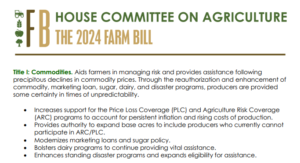The Agriculture Department has finalized some revisions to two major farm commodity programs, including rules for adding new base acres, but signup for the programs won’t be scheduled until after…
Cost Estimate Says House Farm Bill Will Raise Deficit
Agri-Pulse’s Philip Brasher reported this past week that “the House Agriculture Committee’s farm bill would boost the federal budget deficit by $33 billion over 10 years, according to an official cost estimate released Friday by the Congressional Budget Office, which refused to change its stance on a budget offset intended to fund changes to commodity programs.”
“The funding gap could force House Republican leaders to either direct the CBO to change its budget estimate or to modify the legislation, if they want to put the bill on the House floor,” Brasher reported. “At issue is a provision in the bill intended to suspend USDA’s use of section 5 under its Commodity Credit Corporation spending authority, essentially a revolving fund.”

Commodity Credit Corporation Disagreement
Brasher reported that “CBO disagrees both with how much USDA is likely to spend from the account and also how much would be saved from the farm bill provision. Because the provision ‘could be interpreted in multiple ways,’ CBO said in the 27-page document it wasn’t clear the bill language would ‘prevent USDA from spending funds under its section 5 authority.'”
“Ultimately, CBO estimated there was a 50% probability the CCC provision could save $3.6 billion from fiscal 2025 through 2033,” Brasher reported. “Meanwhile, CBO estimated the bill would increase the cost of commodity programs by $43.4 billion over the same period. Other cuts in the bill lower the bill’s net cost increase to $33 billion.”
“In a statement, (House Ag Chairman Glenn ‘GT’) Thompson said he would work with CBO and the Budget Committee, chaired by Rep. Jodey Arrington, a Texas Republican who represents a major cotton-producing district, ‘to bring about a clear-eyed, defensible interpretation of restricting Section 5 discretionary authority,'” Brasher reported. “Arrington could theoretically direct the CBO to give the CCC provision the budget score that Republicans want, but that could risk a political backlash in the House and won’t be accepted in the Democratic-controlled Senate in any case.”
“‘Unfortunately, the score relies on the same methodology that has led CBO to underestimate Commodity Credit Corporation (CCC) outlays by more than $60 billion over the past seven fiscal years,'” Thompson said, according to Progressive Farmer’s Jerry Hagstrom.
Hagstrom reported that Rep. David Scott, D-Ga., the ranking member on the House Agriculture Committee, said that “the CBO score is the latest evidence that Republicans have problems with their farm bill and will need Democrats to pass it. Only by working together can we make progress. Republicans must return to the negotiating table and work with Democrats to craft a truly bipartisan farm bill.”
What are the Increases in Spending in the Bill?
Hagstrom reported at the end of last week that “the biggest boost in spending would be in the commodity title where Price Loss Coverage (PLC) would increase in spending $34.9 billion from 2024-2033 and Agricultural Risk Coverage (ARC) would go up $9.8 billion.”
“Those higher costs would be offset by a freeze in the Supplemental Nutrition Assistance Program (SNAP) ‘Thrifty Food Plan’ that CBO scores as $29.4 billion in savings,” Hagstrom reported.
Brasher reported that “the cost of the Dairy Margin Coverage program would increase by $300 million, in part because the bill would allow participating producers to update the amount of eligible production.”
“The cost of the federal crop insurance program is increased by $3.5 billion, in part by increasing premium subsidies for the Supplemental Coverage Option. Some $1.5 billion of that increase would come from increased administrative and operating funding for the insurance industry,” Brasher reported. “The bill would bring $13.2 billion in Inflation Reduction Act conservation funding into the bill, which would have the effect of permanently increasing funding levels for several other conservation programs.”





